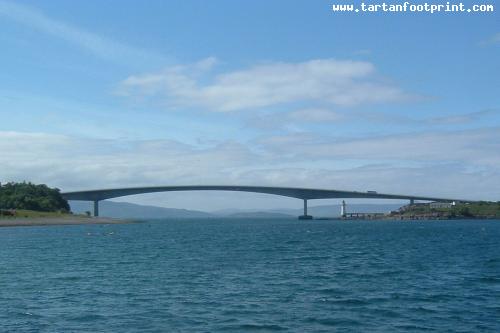You seem to be using an older version of Internet Explorer. This site requires Internet Explorer 8 or higher. Update your browser here today to fully enjoy all the marvels of this site.
May 24, 2018 by Alexander Meldrum
The Isle of Skye
Skye, or the Isle of Skye (/ska?/; Scottish Gaelic: An t-Eilean Sgitheanach or Eilean a' Cheò), is the largest and northernmost of the major islands in the Inner Hebrides of Scotla...The Isle of Skye
Skye, or the Isle of Skye (/ska?/; Scottish Gaelic: An t-Eilean Sgitheanach or Eilean a' Cheò), is the largest and northernmost of the major islands in the Inner Hebrides of Scotland.
The island's peninsulas radiate from a mountainous centre dominated by the Cuillins, the rocky slopes of which provide some of the most dramatic mountain scenery in the country.
Although it has been suggested that the Gaelic Sgitheanach describes a winged shape there is no definitive agreement as to the name's origins.
The island has been occupied since the Mesolithic period, and its history includes a time of Norse rule and a long period of domination by Clan MacLeod and Clan Donald.
The 18th century Jacobite risings led to the breaking up of the clan system and subsequent Clearances that replaced entire communities with sheep farms, some of which also involved forced emigrations to distant lands.
Resident numbers declined from over 20,000 in the early 19th century to just under 9,000 by the closing decade of the 20th century. Skye's population increased by 4 per cent between 1991 and 2001.
About a third of the residents were Gaelic speakers in 2001, and although their numbers are in decline, this aspect of island culture remains important.
The main industries are tourism, agriculture, fishing and forestry. Skye is part of the Highland Council local government area. The island's largest settlement is Portree, known for its picturesque harbour.
There are links to various nearby islands by ferry and, since 1995, to the mainland by a road bridge. The climate is mild, wet and windy. The abundant wildlife includes the golden eagle, red deer and Atlantic salmon.
The local flora are dominated by heather moor, and there are nationally important invertebrate populations on the surrounding sea bed.
Skye has provided the locations for various novels and feature films and is celebrated in poetry and song.
Etymology
The first written references to the island are Roman sources such as the Ravenna Cosmography, which refers to Scitis and Scetis, which can be found on a map by Ptolemy.
One possible derivation comes from skitis, an early Celtic word for winged, which may describe how the island's peninsulas radiate out from a mountainous centre.
Subsequent Gaelic-, Norse- and English-speaking peoples have influenced the history of Skye; the relationships between their names for the island are not straightforward.
Various etymologies have been proposed, such as the "winged isle" or "the notched isle" but no definitive solution has been found to date; the place name may be from an earlier, non-Gaelic language.
In the Norse sagas Skye is called Skíð, for example in the Hákonar saga Hákonarsonar and a skaldic poem in the Heimskringla from c. 1230 contains a line that translates as "the hunger battle-birds were filled in Skye with blood of foemen killed".
The island was also referred to by the Norse as Skuy (misty isle),[16] Skýey or Skuyö (isle of cloud).
The traditional Gaelic name is An t-Eilean Sgitheanach (the island of Skye), An t-Eilean Sgiathanach being a more recent and less common spelling. In 1549 Donald Munro, High Dean of the Isles, wrote of "Sky":
This Ile is callit Ellan Skiannach in Irish, that is to say in Inglish the wyngit Ile, be reason it has mony wyngis and pointis lyand furth fra it, throw the dividing of thir foirsaid Lochis, but the meaning of this Gaelic name is unclear.
Eilean a' Cheò, which means island of the mist (a translation of the Norse name), is a poetic Gaelic name for the island.
Geography
At 1,656 square kilometres (639 sq mi), Skye isthe second-largest island in Scotland after Lewis and Harris. The coastline of Skye is a series of peninsulas and bays radiating out from a centre dominated by the Cuillin hills (Gaelic:
An Cuiltheann). Malcolm Slesser suggested that its shape "sticks out of the west coast of northern Scotland like a lobster's claw ready to snap at the fish bone of Harris and Lewis" and W. H. Murray, commenting on its irregular coastline, stated that
Skye is sixty miles [100 km] long, but what might be its breadth is beyond the ingenuity of man to state". Martin Martin, a native of the island, reported on it at length in a 1703 publication. His geological observations included a note that:
The islands of Raasay, Rona, Scalpay and Pabay all lie to the north and east between Skye and the mainland.
Towns and villages
Portree in the north at the base of Trotternish is the largest settlement (estimated population 2,264 in 2011) and is the main service centre on the island.
Broadford, the location of the island's only airstrip, is on the east side of the island and Dunvegan in the north-west is well known for its castle and the nearby Three Chimneys restaurant.
The 18th-century Stein Inn on the Waternish coast is the oldest pub on Skye. Kyleakin is linked to Kyle of Lochalsh on the mainland by the Skye Bridge, which spans the narrows of Loch Alsh.
Uig, is the port for ferries to the Outer Hebrides, on the west of the Trotternish peninsula and Edinbane is between Dunvegan and Portree. Much of the rest of the population lives in crofting townships scattered around the coastline.
Much of the rest of the population lives in crofting townships scattered around the coastline.
For more facts go to Wikipedia.
In this photo:


